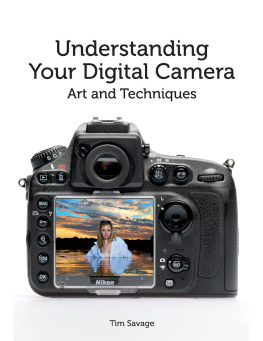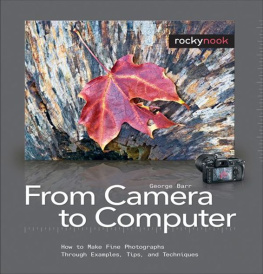The Soul of
the Camera
THE PHOTOGRAPHERS PLACE IN PICTURE-MAKING
David duChemin

The Soul of the Camera
THE PHOTOGRAPHERS PLACE IN PICTURE-MAKING
David duChemin
www.davidduchemin.com
PROJECT EDITOR Ted Waitt
PROJECT MANAGER Lisa Brazieal
COPYEDITOR Cynthia Haynes
INTERIOR DESIGN Andrew Massiatte Lpez
INTERIOR LAYOUT Kim Scott, Bumpy Design
COVER DESIGN Andrew Massiatte Lpez
ISBN 978-1-68198-202-1
1st Edition (1st printing, May 2017)
2017 David duChemin
All images David duChemin
Rocky Nook Inc.
1010 B Street, Suite 350
San Rafael, CA 94901
USA
www.rockynook.com
Distributed in the U.S. by Ingram Publisher Services
Distributed in the UK and Europe by Publishers Group UK
LIBRARY OF CONGRESS CONTROL NUMBER
2016944452
All rights reserved. No part of the material protected by this copyright notice may be reproduced or utilized in any form, electronic or mechanical, including photocopying, recording, or by any information storage and retrieval system, without written permission of the publisher.
Many of the designations in this book used by manufacturers and sellers to distinguish their products are claimed as trademarks of their respective companies. Where those designations appear in this book, and Rocky Nook was aware of a trademark claim, the designations have been printed in caps or initial caps. All product names and services identified throughout this book are used in editorial fashion only and for the benefit of such companies with no intention of infringement of the trademark. They are not intended to convey endorsement or other affiliation with this book.
While reasonable care has been exercised in the preparation of this book, the publisher and author assume no responsibility for errors or omissions, or for damages resulting from the use of the information contained herein or from the use of the discs or programs that may accompany it.
This book is printed on acid-free paper.
Printed in Korea
With heartfelt gratitude to the team that made this book happen,
the friends and family who love and support me, and the readers who
continue to find value in my words. Without you this book, and the
others that came before it, would not have been made, nor would there
have been a reason for making it. Thank you for your continued trust
in me. And thank you for allowing me to play a part, however small, in
your journey, and for playing so vital a part in my own.
About the Author
DAVID DUCHEMIN IS A HUMANITARIAN and world photographer. He has photographed on all seven continents, looking for adventure and beauty along the way. He is the author of several books about the craft and art of photography, including Within the Frame, Photographically Speaking, and The Visual Toolbox. He is the accidental founder of CraftandVision.com an online educational resource for photographersand a passionate fan of the amateur.
Davids work can be found online at DavidDuChemin.com , as can his blog and the growing community of photographers who read it.
Table of Contents
It is we who put the humanity, the vision, and the poetry into our photographs.
Introduction
I HAVE 20 CAMERAS IN MY OFFICE where I sit with my coffee, looking for the words to begin another book. Some of them are 50-year-old film cameras that rest on a shelf and remind me of my beginnings in this art, and they are too rarely used. Some are faithful workhorses, some go underwater. My latest camera flies. And one of them is a phone. I make, depending on the year, 100,000 photographs annually. Some of them are good. Most are not. And if the internets testimony about itself is to be believed, in 2014 we uploaded 1.8 billion images per day to social media sites like Instagram and Facebook. Thats 657 billion photographs a year, made by an equally astonishing number of cameras. That tells me two things. The first: there is an incredible hunger to make and share images. The second: knowing how to use a complicated camera no longer serves as a barrier to creating those images.
Of those hundred thousand images I might make in a year, only a fraction of them work at a level I consider a success. The rest fall short. For the most part, they do not fall short because they are not in focus or well-exposed; the camera does so much of that technical work better than I can these days. They fall short for lack of soul. And when the images succeed in doing what I hoped they would, it is not generally to the cameras credit.
As the number of images created and sharedworldwide, every dayincreases, so too does the noise. And the noisier it becomes, the harder it is to be heard. Responding to this noise with more noise only makes it harder. The answer is not more photographs. Not more noise. The answer is more signal. The answer is photographs that connect, photographs that rise above the banal and the solipsistic, the selfie and the trivial. The answer is more humanity. More soul.
If the camera and its resulting photographs are to have that soul, it will come from us. It is we who put the humanity, the vision, and the poetry into our photographs.
I celebrate the marvel that the camera is. As a boy of 15, seeing an image emerge from nothing in the darkroom of my youth was as close to a miracle as my young eyes had seen. But this book challenges the idea that the camera and the lens and the settingshowever miraculous they areare anything more than dumb and mute tools. It is my hope that this book elevates the individual and calls, once again, for us to look past the megapixels and the sharpness and the giddy excitement of new gear to something deeper andif were being honestmuch more difficult. It is easy to create photographs that showcase the features of the latest camera or lens. It is much harder to reveal our souls, to take a risk, to create something that showcases our vision and our humanity.
Why I go down this road at all is because I am in love with the photograph and all its astonishing capacity, as a tool, to tell stories, to spark the imagination, to leverage empathy in the human heart and create change. I believe more and more every day that the camera, working with time and light as its raw materials, can help us to see life with wider eyes, revel in moments wed otherwise forget in the constant tide of incoming moments, and share those moments with others. The camera on its own is a wonder, but in the hands of the poet, the storyteller, the seeker of change, or the frustrated artist, it can create something alive that touches our humanity.
The photograph can be an astonishing means of connecting and communicating. But first we must have something to say. Even when all weve got is a hurried, Hey, look at that! the photograph can help us say, Look at that, in a hundred ways. Yes, some of those ways require technical knowledge, and there is, as Ill discuss later in the book, a place for craft. But many of them rely on less technical choiceswhere we stand, which moment we choose, what we include and what we exclude from the frame. Indeed, the best photographs rely more on the fact that the photographer saw something the rest of us overlooked in the first place. To make those kinds of photographs, you have to be present, with an open mind, and see the world in a unique way.









